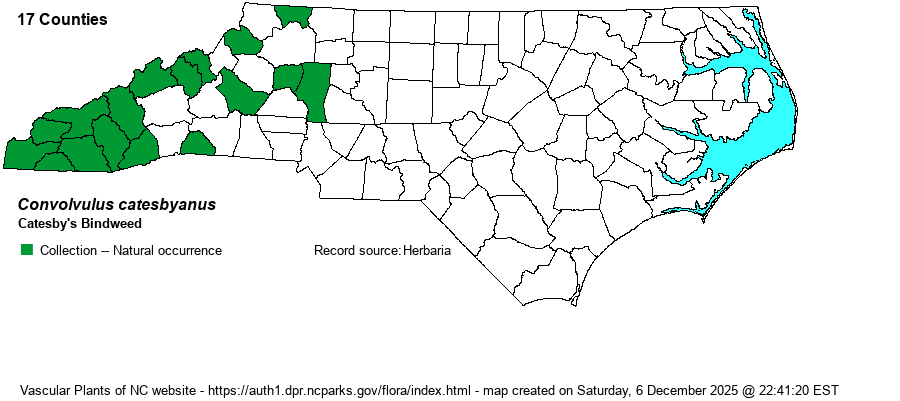| Author | (Pursh) Elliott | |
| Distribution | This species includes most of the former Calystegia sericata and part of the former Calystegia spithamaea. It is found over most of the Mountains, and ranges into the western Piedmont east to Iredell County. Primarily found in the southwestern half of the Mountains.
This Southeastern species occurs from western VA to KY, and south to western FL and MS. | |
| Abundance | Uncommon in the southern Mountains, but rare or very uncommon in the central and morthern Mountains; very rare in the western Piedmont. Owing to the shifting around of taxa names, older specimens may not be annotated with these newer scientific names, and thus the true abundance in the state is somewhat uncertain. | |
| Habitat | This species, as do all bindweeds, favor sunny to partly sunny places, but this species grows mostly on high pH and rich soil. It grows best along the borders of Rich Cove Forests, Basic Mesic Forests, and other openings and edges of similar high pH soil forests or thickets. | |
| Phenology | Blooms from May to July, and fruits shortly after flowering. | |
| Identification | The members of the genus are herbaceous vines. This species twines in the upper parts of the stem, which can grow to 3-4 feet long (0.8 - 1.4 m). All have fairly large and ovate leaves, usually cordate at the base, that are alternate on the stem. This species can be separated from the very similar C. purshianus as that species is not twining and grows only up to 2 feet long. This latter species has "leaves overtopping the stem apex by 1.5-6 cm" (Weakley 2024), whereas C. catesbyanus has "leaves overtopping stem apex by < 1 cm" (Weakley 2024). The large white funnel-shaped flowers are 2-3 inches long and spread, as are others in the group. In this species, the flowers are only from the lower leaf axils. Some other species have flowers from the upper and middle leaf axils. The very similar C. sericatus has its leaves "densely white-tomentose beneath" (Weakley 2024), as opposed to "pubescent or glabrous, but not densely white-tomentose beneath". Needless to say, the recent splitting and shuffling of species in the former Calystegia have meant that identifying these species is now tricky, and you likely will need to refer to botanical keys such as in Weakley (2024). | |
| Taxonomic Comments | See Distribution.
| |
| Other Common Name(s) | None? | |
| State Rank | S3 | |
| Global Rank | G4G5 | |
| State Status | | |
| US Status | | |
| USACE-agcp | | |
| USACE-emp | | |

